|
The Lithographs
Lithographs of John C. Menihan
of John C. Menihan

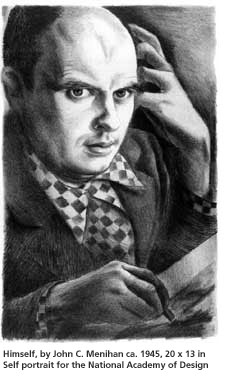
by
Ron Netsky
One
of the most important chapters in the long and varied artistic career
of John C. Menihan (1908-1992) was his two-decade-long involvement
with lithography. From the early 1930s to the early 1950s, Menihan,
who lived in Rochester, New York, created more than 100 lithographs
which constitute a significant body of prints that rivals the finest
work of regionalist and American Scene printmakers.
 Although
Menihan's expressive realism may draw comparisons with the work
of Grant Wood and Thomas Hart Benton, his style has distinctive
qualities that set him apart from other artists of his generation.
His fascination with rural and urban life, recreation and industry,
and people in their environments imbues his prints with an authenticity
seldom matched. And his technical knowledge of the medium gleaned
from his mentor, master lithographer Bolton Brown, is equal to that
of the period's greatest printmakers. Although
Menihan's expressive realism may draw comparisons with the work
of Grant Wood and Thomas Hart Benton, his style has distinctive
qualities that set him apart from other artists of his generation.
His fascination with rural and urban life, recreation and industry,
and people in their environments imbues his prints with an authenticity
seldom matched. And his technical knowledge of the medium gleaned
from his mentor, master lithographer Bolton Brown, is equal to that
of the period's greatest printmakers.
 Menihan's
first encounter with lithography came in the late 1920s while he
was attending the University of Pennsylvania's Wharton School of
Business. Exhibitions he attended in Philadelphia galleries Menihan's
first encounter with lithography came in the late 1920s while he
was attending the University of Pennsylvania's Wharton School of
Business. Exhibitions he attended in Philadelphia galleries 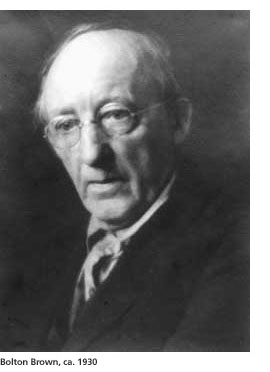 by
Joseph Pennell, James A. McNeill Whistler and Robert Riggs spurred
his interest in the medium. by
Joseph Pennell, James A. McNeill Whistler and Robert Riggs spurred
his interest in the medium.
 Menihan
found his way to Brown's studio at the urging of Walter Cassebeer,
a Rochester architect who also made lithographs. Menihan had seen
an exhibition of Cassebeer's lithographs in the early 1930s and
asked him for advice on getting started in the medium. Cassebeer
recommended Brown's recently published book Lithography for Artists,
and once he acquired it, Menihan was anxious to study with its author.
Brown's name was already familiar to Menihan because he had received
a book of lithographs by George Bellows (many of which were printed
by Brown) for a graduation present. Menihan
found his way to Brown's studio at the urging of Walter Cassebeer,
a Rochester architect who also made lithographs. Menihan had seen
an exhibition of Cassebeer's lithographs in the early 1930s and
asked him for advice on getting started in the medium. Cassebeer
recommended Brown's recently published book Lithography for Artists,
and once he acquired it, Menihan was anxious to study with its author.
Brown's name was already familiar to Menihan because he had received
a book of lithographs by George Bellows (many of which were printed
by Brown) for a graduation present.
 In
Menihan's 1940 application for a National Endowment for the Arts
grant he wrote that his approach to lithography was "mainly based
on a way of thinking acquired at the feet of Bolton Brown." In
Menihan's 1940 application for a National Endowment for the Arts
grant he wrote that his approach to lithography was "mainly based
on a way of thinking acquired at the feet of Bolton Brown."
 "...the richness of my association with him is indescribable. He
was unsurpassed as a technician and inspiring as a man, demanding
perfection and capable of instilling his ideals in others willing
to hear him. He was truly the only important influence on my life
as an artist." "...the richness of my association with him is indescribable. He
was unsurpassed as a technician and inspiring as a man, demanding
perfection and capable of instilling his ideals in others willing
to hear him. He was truly the only important influence on my life
as an artist."
 Menihan
was at the beginning of his career when he encountered Brown, who
was near the end of his. Brown (1864-1936) had been a founder of
Byrdcliffe, the artists' colony in Woodstock, NY and the printer
of more than 100 lithographs by Bellows. Although Brown was himself
an accomplished painter Menihan
was at the beginning of his career when he encountered Brown, who
was near the end of his. Brown (1864-1936) had been a founder of
Byrdcliffe, the artists' colony in Woodstock, NY and the printer
of more than 100 lithographs by Bellows. Although Brown was himself
an accomplished painter 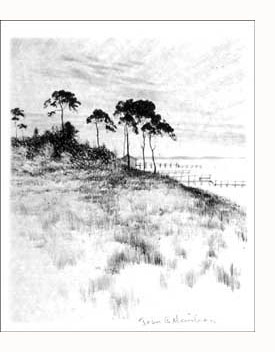 and
lithographer, he was not adequately recognized for his significant
contributions to lithography at the time. (Brown's work began to
attract interest in the late 1970s.) and
lithographer, he was not adequately recognized for his significant
contributions to lithography at the time. (Brown's work began to
attract interest in the late 1970s.)
 The
lack of attention to his work during his lifetime was a major source
of Brown's bitterness about the art world in 1934 when Menihan became
his last student. Brown had witnessed the ascent of men like Joseph
Pennell, who knew very little about the complex process of lithography,
while his own career languished. He nevertheless created hundreds
of delicate, technically unsurpassed lithographs. He also undertook
more experimentation in the chemistry of lithography and the making
of lithographic crayons than anyone in the history of the medium.
When Menihan studied with Brown in 1934 and 1935, it is no exaggeration
to say that he was under the tutelage of the world's foremost expert
in lithography. The
lack of attention to his work during his lifetime was a major source
of Brown's bitterness about the art world in 1934 when Menihan became
his last student. Brown had witnessed the ascent of men like Joseph
Pennell, who knew very little about the complex process of lithography,
while his own career languished. He nevertheless created hundreds
of delicate, technically unsurpassed lithographs. He also undertook
more experimentation in the chemistry of lithography and the making
of lithographic crayons than anyone in the history of the medium.
When Menihan studied with Brown in 1934 and 1935, it is no exaggeration
to say that he was under the tutelage of the world's foremost expert
in lithography.
 By
the mid 1930s, however, Brown was practically destitute. His modest
home, on Zena Road, two miles from Woodstock, had no electricity
or running water, and his studio, located behind the house, was
heated by a wood-burning stove. Brown was suffering from cancer
at the time, but he refused to go to a hospital, preferring instead
to spend his last years in familiar surroundings. By
the mid 1930s, however, Brown was practically destitute. His modest
home, on Zena Road, two miles from Woodstock, had no electricity
or running water, and his studio, located behind the house, was
heated by a wood-burning stove. Brown was suffering from cancer
at the time, but he refused to go to a hospital, preferring instead
to spend his last years in familiar surroundings.
 Brown
sat in a fan-back wicker chair and instructed Menihan through chapter
after chapter of his book. While Menihan worked stones, Brown, whose
quest for knowledge was undiminshed, read Hacklet's Vogages, a history
of the world composed of original documents. Brown
sat in a fan-back wicker chair and instructed Menihan through chapter
after chapter of his book. While Menihan worked stones, Brown, whose
quest for knowledge was undiminshed, read Hacklet's Vogages, a history
of the world composed of original documents. 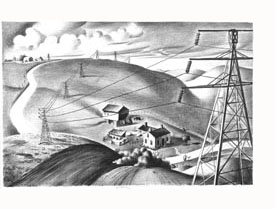 A
sign hanging in Brown's studio proclaimed, "Into the making of a
perfect work, time is an element that does not enter." A
sign hanging in Brown's studio proclaimed, "Into the making of a
perfect work, time is an element that does not enter."
 Menihan
learned how to make his own grease crayons, a skill few lithographers
possessed, and he learned the intricacies of etching and printing
stones. He also learned, in no uncertain terms, the meaning of the
sign hanging in the studio. Menihan
learned how to make his own grease crayons, a skill few lithographers
possessed, and he learned the intricacies of etching and printing
stones. He also learned, in no uncertain terms, the meaning of the
sign hanging in the studio.
 One
summer, when Menihan had finished his work, Brown asked him to separate
his lithographs into three piles: best, medium and discards. After
discussing the quality of the work, Brown asked Menihan what he
planned to do with the prints, and Menihan said he guessed he would
take them home. Brown struggled up out of his chair, hobbled over
to the prints, picked up the "discard" pile and, tossing the prints
into the flames of the wood-burning stove, said "This is what you
do with work that's not perfect." He then picked up the "medium" pile and tossed them, too, into the stove, leaving only the two
perfect prints. One
summer, when Menihan had finished his work, Brown asked him to separate
his lithographs into three piles: best, medium and discards. After
discussing the quality of the work, Brown asked Menihan what he
planned to do with the prints, and Menihan said he guessed he would
take them home. Brown struggled up out of his chair, hobbled over
to the prints, picked up the "discard" pile and, tossing the prints
into the flames of the wood-burning stove, said "This is what you
do with work that's not perfect." He then picked up the "medium" pile and tossed them, too, into the stove, leaving only the two
perfect prints.
 Menihan
obivously learned his lesson well because his lithographs were meticulously
executed. Menihan
obivously learned his lesson well because his lithographs were meticulously
executed. 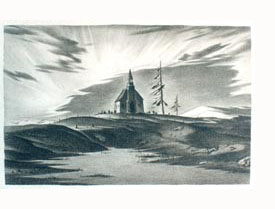 Over
the next two decades (1935-1955) Menihan produced more than 100
lithographs, each of them beautifully drawn and flawlessly printed.
At a time when many artists merely drew images on stone and hired
professionals to make the prints, Menihan did it all himself. Consequently,
his lithographs exemplify a wonderful union of content and technique. Over
the next two decades (1935-1955) Menihan produced more than 100
lithographs, each of them beautifully drawn and flawlessly printed.
At a time when many artists merely drew images on stone and hired
professionals to make the prints, Menihan did it all himself. Consequently,
his lithographs exemplify a wonderful union of content and technique.
 Brown's
influence is evident in Menihan's early lithographs. In several
of them, Menihan outlined the composition with an unruled line in
a manner characteristic of Brown's work. In early prints, he also
used the expressive, autographic strokes that were all hallmark
of Brown's landscapes. As Menihan grew more confident in his own
style, these characteristics gave way to a subtle, continuous-tone
shading in combination with a strong line. Brown's
influence is evident in Menihan's early lithographs. In several
of them, Menihan outlined the composition with an unruled line in
a manner characteristic of Brown's work. In early prints, he also
used the expressive, autographic strokes that were all hallmark
of Brown's landscapes. As Menihan grew more confident in his own
style, these characteristics gave way to a subtle, continuous-tone
shading in combination with a strong line.
 After
Brown's death, Menihan, who had studied business in college, helped
Brown's family with his artistic estate. Apparently in appreciation
for his help, Brown's family sent several packages of prints to
Menihan in the months that followed. In 1988 he and his wife, Margaret,
donated their collection of more that 50 of Brown's lithographs
to Rochester's art museum, the Memorial Art Gallery, endowing the
gallery with one of the most significant collections of Brown's
prints in the United States. After
Brown's death, Menihan, who had studied business in college, helped
Brown's family with his artistic estate. Apparently in appreciation
for his help, Brown's family sent several packages of prints to
Menihan in the months that followed. In 1988 he and his wife, Margaret,
donated their collection of more that 50 of Brown's lithographs
to Rochester's art museum, the Memorial Art Gallery, endowing the
gallery with one of the most significant collections of Brown's
prints in the United States.
 Menihan's
NEA grant application also sheds light on his motivation and the
aesthetic ideals behind his lithographic career. His goal, he writes,
was to "produce a group of lithographs which would interpret the
life and thinking of the Northeastern section of the United States." Menihan's
NEA grant application also sheds light on his motivation and the
aesthetic ideals behind his lithographic career. His goal, he writes,
was to "produce a group of lithographs which would interpret the
life and thinking of the Northeastern section of the United States."
 At
a time when many artistis of his generation were turning to the
various forms of abstraction in vogue in the 1940's, At
a time when many artistis of his generation were turning to the
various forms of abstraction in vogue in the 1940's, 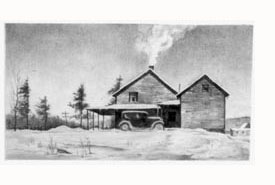 Menihan
wrote of his impluse to deal in a representational manner with subjects "...intermixed with the course of my life, factories in which I
worked as a boy, cities in which I've studied, lake freighters,
county fairs, summer resorts, farm houses, tenements, and country
clubs." Menihan
wrote of his impluse to deal in a representational manner with subjects "...intermixed with the course of my life, factories in which I
worked as a boy, cities in which I've studied, lake freighters,
county fairs, summer resorts, farm houses, tenements, and country
clubs."
 He
did not see his work as "photographic" documents but, rather as
expressions of character. One of the reasons he gives for employing
a print-making medium is the ability to "disperse among laymen the
benefits derived from possession of works of art." He
did not see his work as "photographic" documents but, rather as
expressions of character. One of the reasons he gives for employing
a print-making medium is the ability to "disperse among laymen the
benefits derived from possession of works of art."
 Menihan's
characteristic modesty is apparent when he deals with the "presumable
significance" of his work: Menihan's
characteristic modesty is apparent when he deals with the "presumable
significance" of his work:
 "It
can only be said that I bring to the project honesty, energy, a
degree of skill and love of my work...Whether or not the world will
choose to consider the result "significant art" is a matter I cannot
here decide." "It
can only be said that I bring to the project honesty, energy, a
degree of skill and love of my work...Whether or not the world will
choose to consider the result "significant art" is a matter I cannot
here decide."
 Through
his long involvement with the Rochester Print Club, Menihan also
met and became friends with such printmakers as Albert Winslow Barker
and Norman Kent. Barker, who had also studied with Brown, shared
his lithographic technical research with Menihan in Rochester and
at his home in Moylan, Pennsylvania. Through
his long involvement with the Rochester Print Club, Menihan also
met and became friends with such printmakers as Albert Winslow Barker
and Norman Kent. Barker, who had also studied with Brown, shared
his lithographic technical research with Menihan in Rochester and
at his home in Moylan, Pennsylvania.
 Kent
wrote about Menihan's lithographs in a 1945 article in American
Artist magazine, quoting the artist e Kent
wrote about Menihan's lithographs in a 1945 article in American
Artist magazine, quoting the artist e xtensively
during the peak of his lithographic activity. In the article, Menihan
discussed the unique properties of the lithographic drawing. xtensively
during the peak of his lithographic activity. In the article, Menihan
discussed the unique properties of the lithographic drawing.
 "Experience
has shown me that because of the distinctive qualities of lithographic
stone as a drawing medium it is almost useless to develop final
drawings on paper, simply because no paper will provide the same
surface for work as a lithograhic stone. The stone itself is an
inspiration; it provides many effects which are especially "lithographic." Therefore, I adopted the practice of drawing the large preliminary
sketch right on stone, and pulling a proof or two, with the idea
of graining another stone for the final rendering." "Experience
has shown me that because of the distinctive qualities of lithographic
stone as a drawing medium it is almost useless to develop final
drawings on paper, simply because no paper will provide the same
surface for work as a lithograhic stone. The stone itself is an
inspiration; it provides many effects which are especially "lithographic." Therefore, I adopted the practice of drawing the large preliminary
sketch right on stone, and pulling a proof or two, with the idea
of graining another stone for the final rendering."
 He
also discussed the reason he preferred to print his own stones at
a time when many artists simply drew on the stone and had a professional
printer pull the prints: "The service of these several excellent
lithographic printers are available, but to me drawing on a stone
and having someone else do the printing is comparable to owning
a new bathing suit, and have friends wear it in swimming." He
also discussed the reason he preferred to print his own stones at
a time when many artists simply drew on the stone and had a professional
printer pull the prints: "The service of these several excellent
lithographic printers are available, but to me drawing on a stone
and having someone else do the printing is comparable to owning
a new bathing suit, and have friends wear it in swimming."
 Menihan's
knowledge of the crayon formulas, gleaned from Brown and Barker,
was especially helpful in making his lithographs distinctive. Menihan's
knowledge of the crayon formulas, gleaned from Brown and Barker,
was especially helpful in making his lithographs distinctive.
 "Graphite
(as an ingredient in the crayon) is Albert Barker's idea and he
should have full credit for working it out. It has meant the difference
between nothing and a whole new technique to me, inasmuch as I have
made big chunks of crayon which do beautiful "grays" with one fell
swoop." "Graphite
(as an ingredient in the crayon) is Albert Barker's idea and he
should have full credit for working it out. It has meant the difference
between nothing and a whole new technique to me, inasmuch as I have
made big chunks of crayon which do beautiful "grays" with one fell
swoop."
 Menihan's
enthusiasm for the vocabulary of lithography is indicative of an
artist who embraced a given medium and extracted from it all the
particular properties it was capable of yielding. The lithograhic
oeuvre of John Menihan embodies the ideal of art as a part of everyday
life, a chronicle of the perceptions and reactions of the artist
to the world around him. Menihan's
enthusiasm for the vocabulary of lithography is indicative of an
artist who embraced a given medium and extracted from it all the
particular properties it was capable of yielding. The lithograhic
oeuvre of John Menihan embodies the ideal of art as a part of everyday
life, a chronicle of the perceptions and reactions of the artist
to the world around him.
 
Ron Netsky is Chairman
of the Art Department
 at
Nazereth College in Rochester, NY at
Nazereth College in Rochester, NY

|





 by
Joseph Pennell, James A. McNeill Whistler and Robert Riggs spurred
his interest in the medium.
by
Joseph Pennell, James A. McNeill Whistler and Robert Riggs spurred
his interest in the medium.



